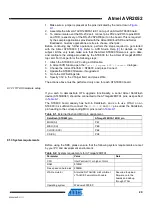
Atmel AVR2052
27
8200M-AVR-11/11
8.4.3 Over-the-air upgrade configuration
Over-the-air upgrade functionality of the Atmel BitCloud SDK can be demonstrated
using the Atmel ZigBit platform. This demonstration requires additional hardware,
namely:
•
A dedicated device running the Runner application and performing the function of
an over-the-air upgrade client
•
One of the supported external Atmel DataFlash devices is connected to the ZigBit
module, as described in Section
and used to store uploaded application
images
NOTE
Only those modules that have a DataFlash device connected to them should be
programmed with the OTAU-capable WSNDemo application. The rest can run the
stock WSNDemo firmware.
Once the external DataFlash device is connected to the board, the user should
configure and install devices as follows:
1. Load the WSNDemo application configured and compiled with APP_USE_OTAU
defined as 1 in the
configuration.h
file:
a. Program the embedded bootloader
bootloaderOTAU_ATmega1281.hex
image file from the Serial
Bootloader package, according to platform-specific instructions.
b. The application image should be converted to
*.srec
format and
installed using the Bootloader PC tool from the same package, as
described in Section
.The device is now able to perform as an
OTA client, as defined in
. The above process should be
repeated for every node that the user intends to upgrade over the
air.
2. Program another device with the Runner application available in the
<SDK-
Root>\Evaluation Tools\Runner\
directory of the SDK. The device is now able
to perform as an OTA server, as defined in
. Once the images are
programmed and WSNDemo devices are joined to the network, follow
to update the firmware over the air.
8.5 Reserved hardware resources
Table 8-11.
Hardware resources reserved by the stack on ZigBit, ZigBit Amp, and
ZigBit 900 modules.
Resource
Description
Processor main clock
8MHz from internal RC oscillator or external radio frequency
SPI
Radio interface
ATmega ports PB0, PB1,
PB2, PB3, PB4, PA7, PE5
Radio interface
ATmega port PC1
Interface for amplifier (if present)
ATmega ports PG3, PG4
Asynchronous timer interface
Timer/Counter 2
Asynchronous timer
Timer/Counter 4
System timer
External IRQ4
Wake up on DTR
External IRQ5
Radio interface
EEPROM
Storage for user settings accessible via persistent data server
PE0, PE1, PE2, PF3
External Atmel DataFlash, when OTAU functionality is used
















































